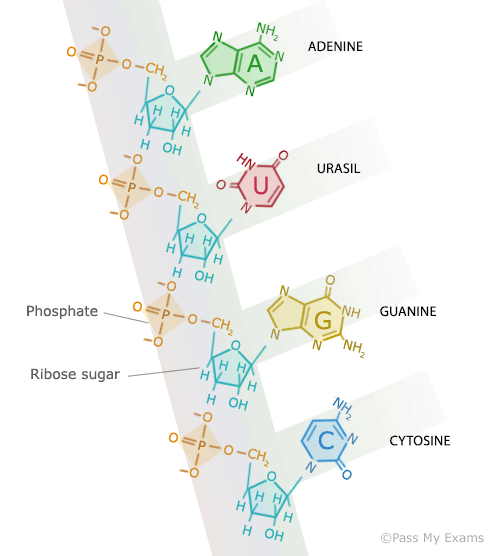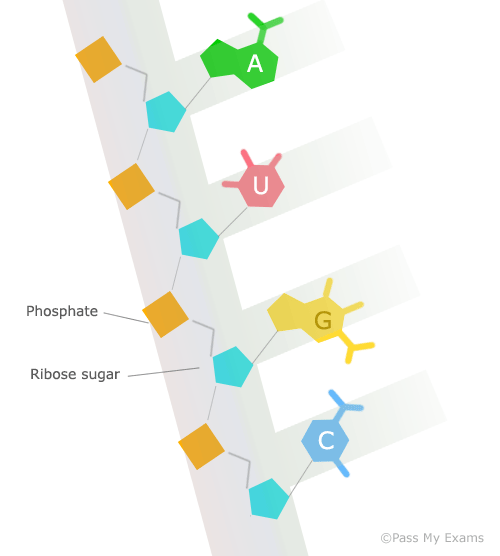Making Proteins (Protein Synthesis)
- Chromosomes are located in the nucleus of the cell.
- Chromosomes are made up of long strands of tightly wound DNA molecules held together with proteins.
- A section of the DNA molecule that controls the development of certain characteristics is called a gene.
Proteins are made up of chains of amino acids. The type and sequence of the amino acids determine the type of protein. The DNA controls the production of different proteins, which is called protein synthesis. The code for creating proteins comes from genes, which are small sections of the DNA. Each gene acts as a code or a set of instructions for making a specific protein.
Proteins are made in structures called ribosomes, which are found in the cytoplasm of the cell. Therefore, the information required to make the protein needs to be transferred from the DNA in the nucleus to the cytoplasm. This is done by a molecule called ribonucleic acid (RNA).
The RNA strand has a similar structure to DNA i.e. a base bonded to a sugar-phosphate backbone. However, unlike DNA, RNA is single stranded. The sugar in the RNA molecule is called a ribose instead of deoxyribose in DNA (ribose contains an additional hydroxyl group). It contains the base uracil instead of thymine which forms a base pair with adenine.
The diagram below shows the structure of RNA.

Following is the simplified structure of RNA:

Protein Synthesis
The main stages of protein synthesis are Transcription and Translocation. Two types of RNA molecules are used in the process; messenger RNA (mRNA) and transfer RNA (tRNA).
Protein synthesis and RNA
The animation below explains the process of protein synthesis and the function of RNA.
Animation summary
Making RNA (Transcription)
The coded instructions for producing a specific protein or RNA molecule are contained in sections of the DNA called genes.
An enzyme unwinds the section of DNA to form RNA. Here the RNA nucleotides line up with their complementary bases transcribing the information from the DNA to RNA. The RNA is made up of ribonucleotides, which are matched to their compliments in the DNA.
A pairs with T
C pairs with G
G pairs with C
U pairs with A
RNA contains the base uracil (U) instead of thymine (T).
RNA Splicing
Segments of the RNA molecule not required for coding of the protein are removed and the remaining section reconnected. This process is called splicing and results in a messenger RNA (mRNA) ready to be used as a template for protein synthesis.
The mRNA leaves the nucleus via the nuclear pores.
Making Proteins (Translation)
The mRNA is translated into a protein in the cytoplasm of the cell. This is done by transfer RNA (tRNA). There are different tRNAs for each of the twenty amino acids that make up proteins. One end of the tRNA molecule holds 3 bases called an anti-codon and these pair with the complimentary bases on the mRNA. On the other end of the tRNA is a specific amino acid.
The tRNA docks onto the mRNA with the help of ribosomes. The ribosomes have sites on which the tRNA molecules can bind. The ribosomes help the amino acid from the first tRNA bond to the amino acid of the second tRNA. On forming the bond the first tRNA molecules leaves and the process is repeated till the ribosome reaches a part of the mRNA that does not code for an amino acid. The ribosome dissociates from the mRNA and the protein is released. The resulting chain of amino acids then folds into a complex three-dimensional shape to form a functional protein.
